Overview
This article focuses on identifying the early symptoms of Type 2 Diabetes, and it’s crucial to recognize these signs. Increased thirst, frequent urination, and fatigue are not just minor inconveniences; they can be important indicators of your health. Understanding these symptoms can lead to timely intervention, which is vital for your well-being.
These symptoms arise from physiological changes due to high blood sugar levels. It’s understandable to feel overwhelmed when faced with such information. However, early detection can significantly improve health outcomes and reduce the risk of complications. Remember, you’re not alone in this journey—many have walked this path and found support.
If you notice these symptoms, consider reaching out for help. There are resources available to guide you through this process, and seeking support can make a difference. We are here to support you every step of the way.
Introduction
Recognizing the early signs of Type 2 diabetes can be a pivotal factor in managing your health and preventing complications. Symptoms such as increased thirst, frequent urination, and fatigue may seem innocuous at first, but they can signal underlying issues that deserve your attention. It's understandable to feel uncertain about these subtle yet significant indicators. How can you differentiate between normal bodily changes and the early warning signs of a serious condition?
This article delves into ten critical early symptoms of Type 2 diabetes that everyone should be aware of, empowering you to take proactive steps toward your health and well-being. Remember, you're not alone in this journey; we are here to support you every step of the way.
T2DSolutions: Your Essential Guide to Early Symptoms of Type 2 Diabetes
At T2DSolutions, we are dedicated to empowering you with essential knowledge about Type 2 Diabetes. Recognizing the diabetes type 2 early symptoms is crucial for effective management and preventing complications. Signs such as increased thirst, frequent urination, and fatigue can significantly impact how you manage your health. By acting promptly, you can change the course of your illness for the better. Experts in diabetes emphasize that early identification is vital; acknowledging these indicators can lead to improved health outcomes and a reduced risk of serious complications.
It's important to note that many individuals experience diabetes type 2 early symptoms before receiving an official diagnosis of Type 2 Diabetes. Research shows that recognizing diabetes type 2 early symptoms can pave the way for successful interventions, including lifestyle changes and medical treatments that are essential for effective management. By understanding and identifying these early warning signs, you can take proactive steps toward your health and well-being, ultimately enhancing your quality of life. Remember, you're not alone in this journey; we are here to support you every step of the way.
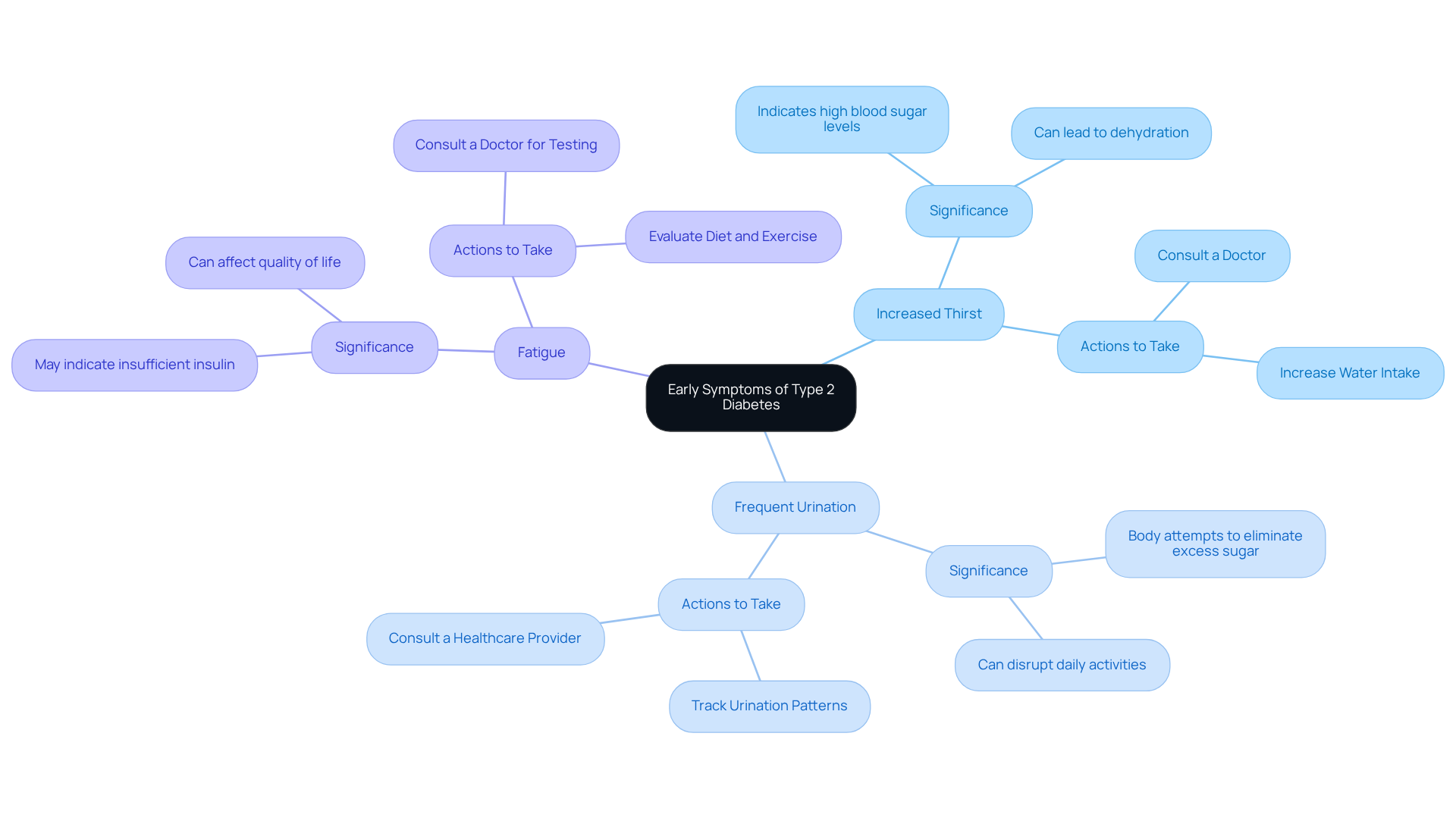
Increased Thirst: A Common Early Warning Sign of Type 2 Diabetes
Heightened thirst, known medically as polydipsia, can often be one of the diabetes type 2 early symptoms. This occurs when elevated blood sugar levels lead to dehydration, prompting your body to expel excess glucose through urine. It's important to recognize that many individuals with diabetes type 2 early symptoms experience polydipsia, making it a crucial indicator to be aware of.
If you've noticed an increase in your fluid intake, please know that it's understandable to feel concerned. Consulting a healthcare provider for further evaluation is a wise step. Early diagnosis is essential because managing diabetes effectively can help prevent complications and improve your overall health outcomes.
Remember, you're not alone in this journey. We are here to support you every step of the way, and seeking help is a sign of strength.
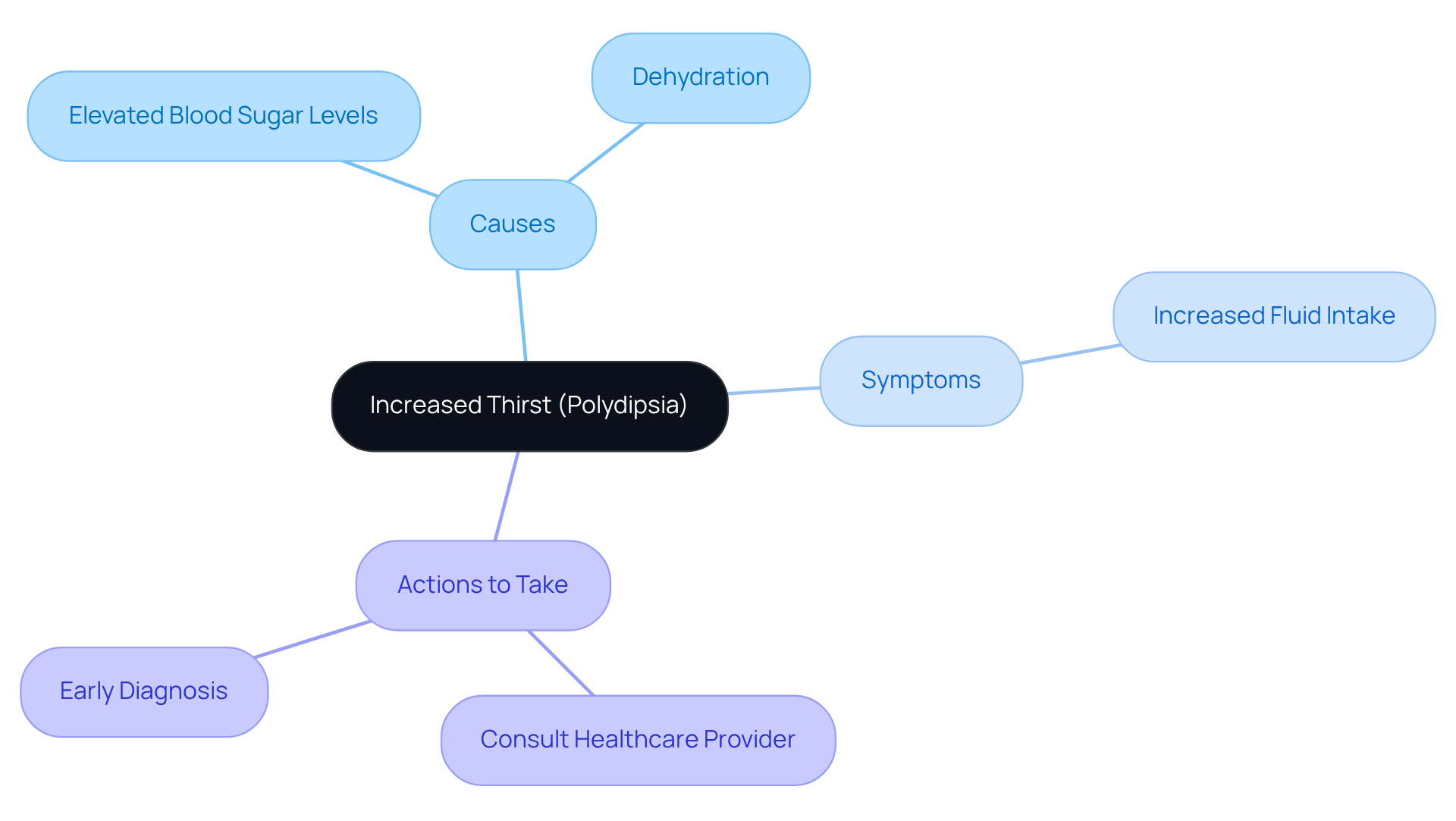
Frequent Urination: Recognizing This Key Symptom of Type 2 Diabetes
Frequent urination, known as polyuria, is an important sign among diabetes type 2 early symptoms that deserves your attention. This condition arises when the kidneys filter excess glucose from the bloodstream, leading to increased urine production. Many patients notice a significant change in their urination habits, with some needing to urinate more than eight times a day or producing up to 15 liters of urine daily. Often, this symptom is accompanied by excessive thirst, referred to as polydipsia, which can make identifying diabetes type 2 early symptoms feel even more challenging.
Real-life experiences underscore the importance of recognizing polyuria. Many individuals who have recently been diagnosed shared that they initially dismissed their frequent urination as a minor issue until they noticed it coincided with diabetes type 2 early symptoms, which prompted them to seek medical advice. One participant reflected, "I was peeing more often than usual, but I thought it was just because I was drinking more water. It wasn't until I felt excessively thirsty that I decided to see my doctor."
The prevalence of polyuria among newly diagnosed patients is significant. Studies indicate that 89% of patients show one or more hyperglycemic signs, including polyuria, often within three months leading up to their diagnosis, which are considered diabetes type 2 early symptoms. Healthcare professionals stress the importance of being aware of the diabetes type 2 early symptoms. As one specialist noted, "Identifying polyuria as a potential indicator of a metabolic disorder can lead to timely diagnosis and intervention, which is crucial for effective management."
Understanding the connection between polyuria and diabetes type 2 early symptoms is vital. It acts as an early warning sign that should not be ignored. If you notice a sudden increase in how often you urinate, especially when paired with increased thirst, it's essential to reach out to a healthcare provider for further evaluation and possible testing.
For more information on managing diabetes-related concerns and to access valuable resources, please visit T2DSolutions, your comprehensive hub for education and support regarding this condition. Remember, you're not alone in this journey; we are here to support you every step of the way.
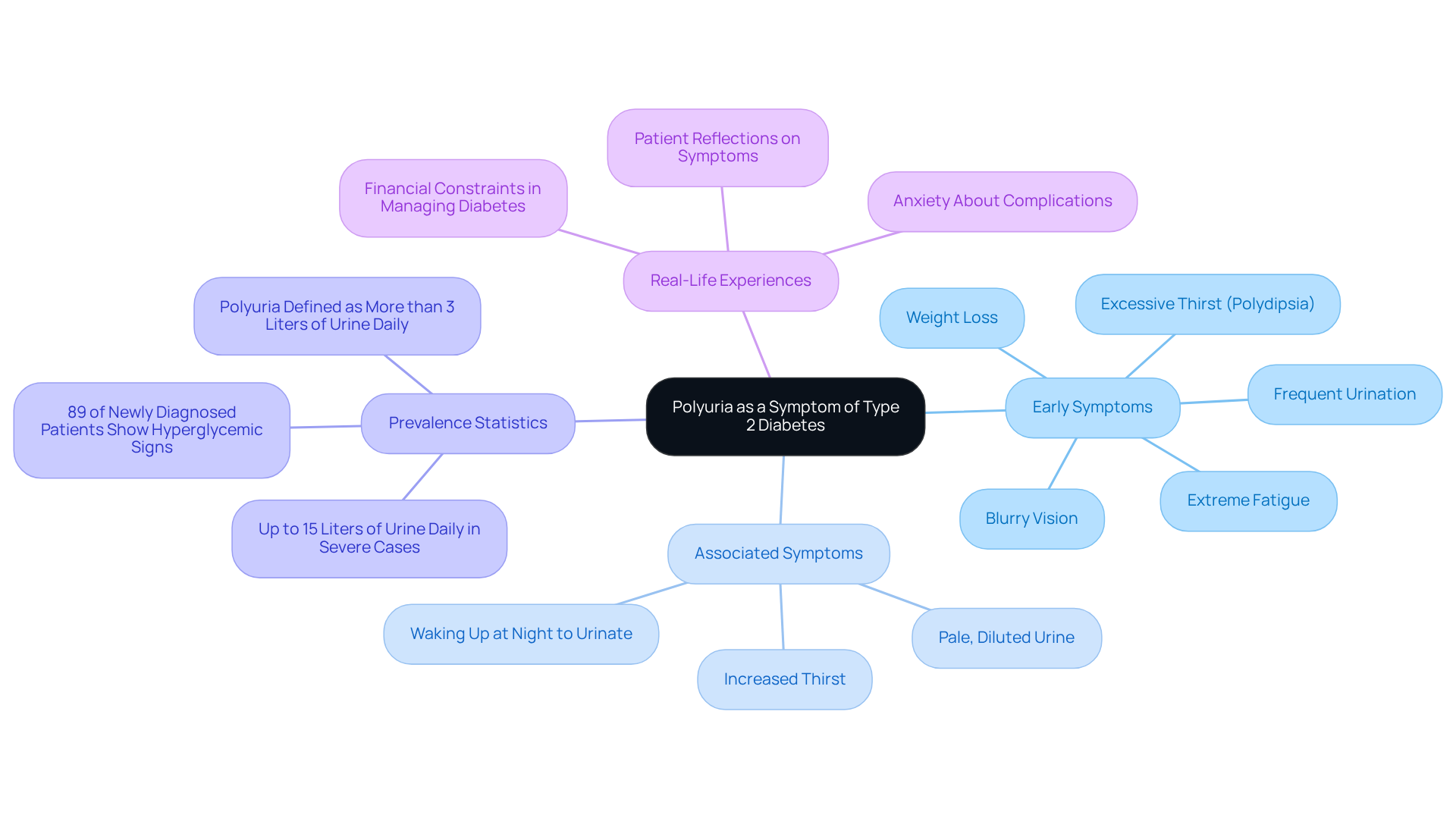
Fatigue: An Overlooked Early Symptom of Type 2 Diabetes
Fatigue is a common yet often overlooked symptom among diabetes type 2 early symptoms. It's understandable that many newly diagnosed patients feel this way; research shows that about 61% report persistent tiredness throughout the day. This fatigue can often be traced back to insulin resistance, where the body struggles to use glucose effectively for energy, resulting in feelings of lethargy. In fact, a study found that 74% of individuals with diabetes-related conditions experience moderate fatigue, with 18% reporting mild fatigue and 8% severe fatigue. This multifaceted issue can significantly affect daily activities and overall quality of life.
Many patients share their experiences of feeling betrayed by their bodies due to overwhelming tiredness. This fatigue can make it challenging to engage in essential self-care tasks, such as meal preparation and exercise. Endocrinologists emphasize the importance of addressing insulin resistance, as it not only contributes to fatigue but also complicates diabetes management. If you find yourself feeling persistently fatigued, especially when accompanied by other signs like increased thirst or frequent urination, it’s crucial to seek advice from a healthcare professional about diabetes type 2 early symptoms. They can provide a thorough assessment and support tailored to your needs.
You're not alone in this journey, and there are resources available to help you navigate these challenges. Remember, taking the first step toward understanding your symptoms is a sign of strength. We are here to support you every step of the way.
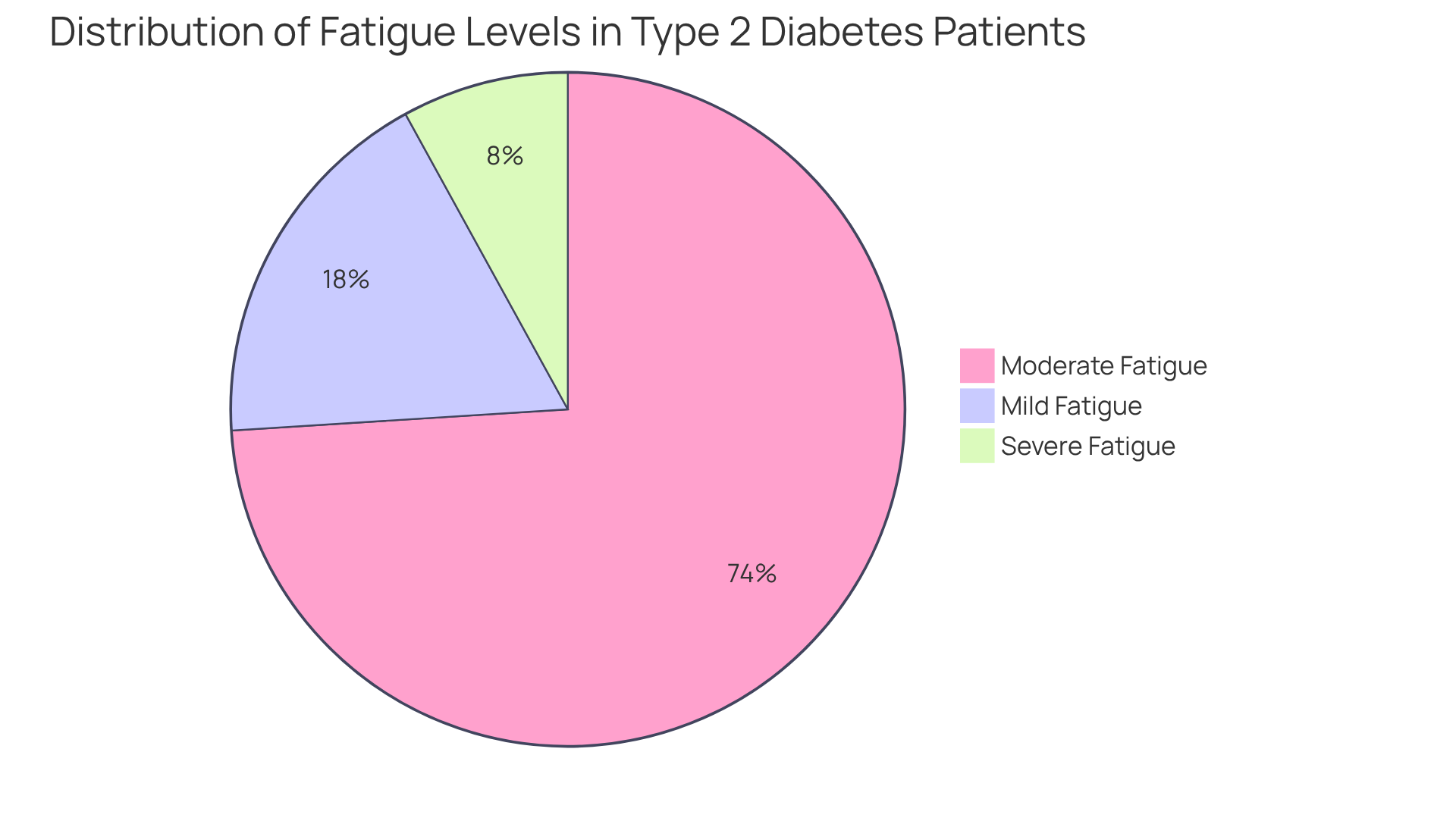
Blurry Vision: A Potential Indicator of Type 2 Diabetes
Blurry vision can often be an early warning sign among diabetes type 2 early symptoms, and it's important to pay attention to this change. Elevated blood sugar levels may lead to swelling of the eye's lens, causing temporary vision alterations. This occurs because high glucose levels can allow fluid to leak into the lens, distorting what you see. It's reported that around 1 in 3 individuals with high blood sugar experience some form of vision change related to diabetic retinopathy (DR), highlighting how common this issue is for those managing elevated glucose levels.
Consider the story of a couple who worked together to control their condition, losing a total of 118 pounds. This significant weight loss not only improved their overall health but also positively impacted their eyesight. By managing their weight, they were able to stabilize their blood sugar levels, which in turn helped their vision. If you're experiencing changes in your vision, especially alongside other diabetes type 2 early symptoms like increased thirst or frequent urination, consulting healthcare professionals is essential. You're not alone in this journey; support is available.
Ophthalmologists stress the importance of keeping blood sugar levels in check to maintain eye health. Dr. Cindy Cai, an ophthalmologist, shares, "In addition to getting your eyes checked, it’s also very important to keep the blood sugars under control. This is not only good for you overall, but also good for your eyes."
It's advisable for individuals with blood sugar conditions to undergo routine eye assessments, including thorough dilated exams, at least once a year. Early detection and treatment can often stabilize vision and prevent further complications. Remember, if you notice any changes in your vision, seeking medical evaluation promptly is vital. We are here to support you every step of the way.
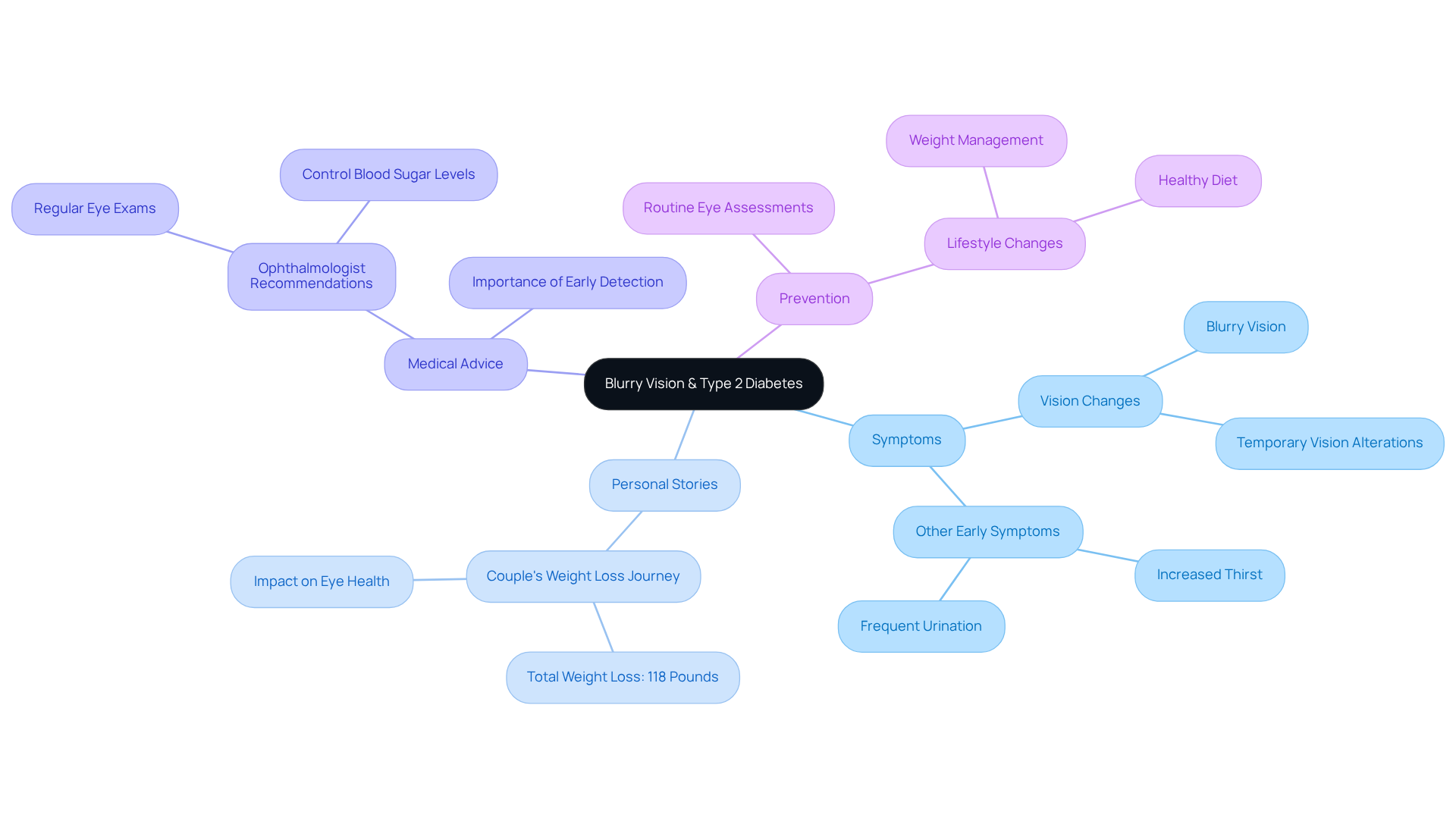
Increased Hunger: Understanding This Early Sign of Type 2 Diabetes
Heightened appetite, known as polyphagia, can be considered one of the diabetes type 2 early symptoms that many newly diagnosed individuals face. When the body struggles to use glucose effectively due to insulin resistance, it can lead the brain to signal for more food, leaving you with persistent hunger. This isn't just a minor issue; it can significantly impact diabetes management. You might find yourself eating more often, which complicates blood sugar control and can lead to weight gain.
Research shows that polyphagia is common among those recently diagnosed, with many reporting increased hunger even after meals. This can be particularly challenging, as it may lead to impulsive eating and difficulty adhering to dietary guidelines. Nutritionists emphasize the importance of recognizing the diabetes type 2 early symptoms early. Managing polyphagia often involves a balanced diet rich in high-fiber foods, proteins, and healthy fats, which can promote feelings of fullness and help stabilize blood sugar levels.
At T2DSolutions, we understand the struggles that come with polyphagia, and we are here to support you. Our platform offers educational resources and practical strategies to help you manage this issue effectively. Many patients share their experiences of feeling unsatisfied after meals, which can lead to excessive snacking or choosing unhealthy options. This cycle can complicate blood sugar management, underscoring the need for effective strategies to address hunger cues.
Consulting with healthcare professionals or registered dietitians can provide personalized advice to help you manage this symptom and improve your overall health. Remember, you're not alone in this journey. We are here to support you every step of the way.
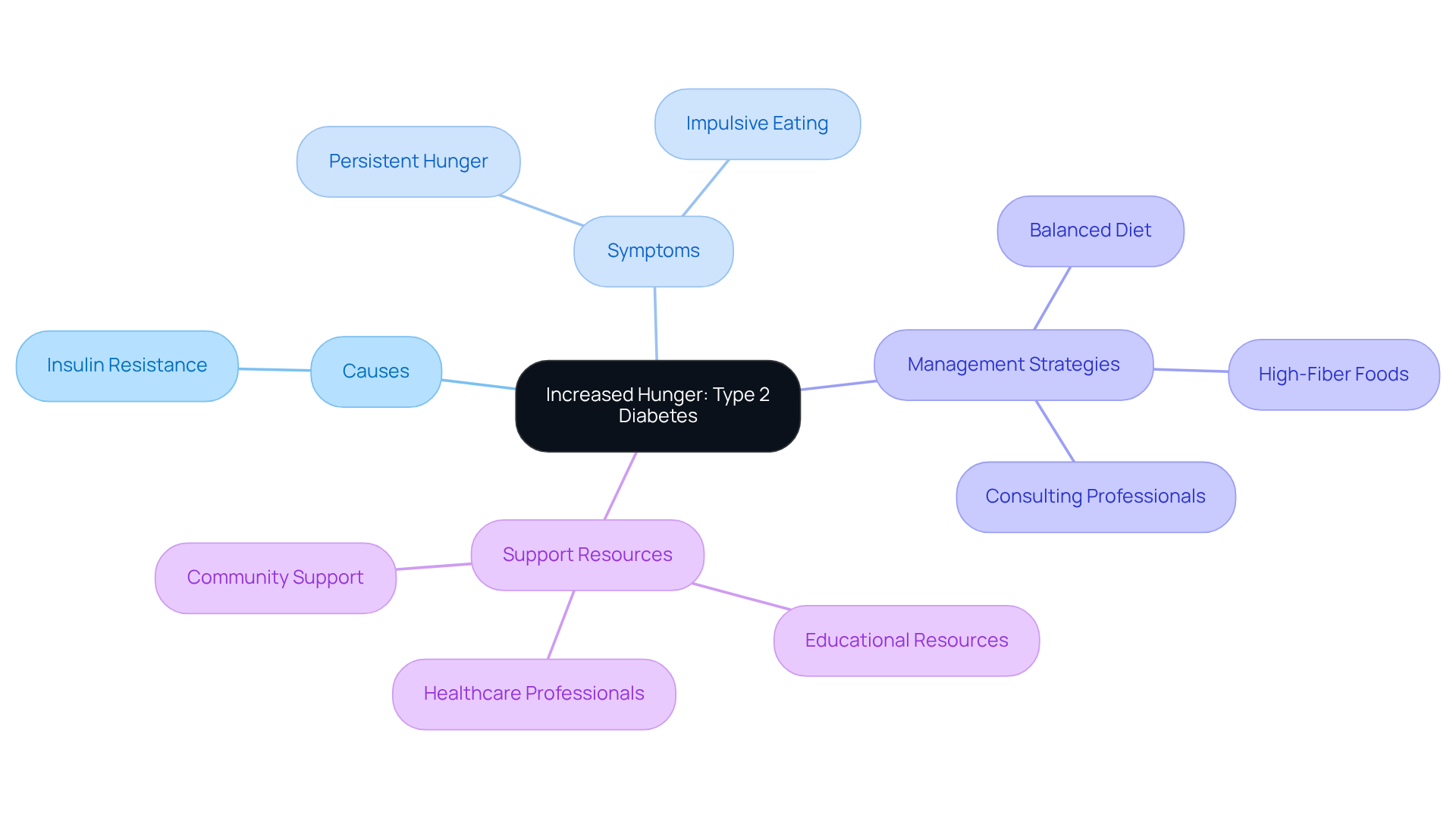
Skin Problems: Recognizing Their Connection to Type 2 Diabetes
Skin issues, such as dry skin, rashes, and infections, can be considered diabetes type 2 early symptoms. High blood sugar levels can disrupt circulation and skin health, leading to various complications. It's important to understand that research indicates up to 80% of patients with diabetes-related conditions experience skin disorders, with infections being the most prevalent, affecting around 31.7% of individuals. Xerosis, or dry skin, is particularly common, impacting approximately one-third of those with blood sugar regulation issues due to dysfunction in sweat and sebaceous glands.
Real-life examples illustrate the seriousness of these complications. Diabetic foot ulcers, which may arise from unnoticed injuries, pose a significant risk of infection and could lead to amputations if not managed properly. Additionally, conditions like diabetic dermopathy, characterized by light brown or red scaly patches, are frequent yet often overlooked.
Dermatologists emphasize the importance of monitoring skin health when managing blood sugar conditions. Effective skin care practices, including the use of emollients and regular skin assessments, can help reduce the risks associated with high blood sugar. As one expert noted, "Proper skin care is essential in preventing skin-related issues in individuals with high blood sugar." If you notice persistent or unusual skin changes, it's crucial to seek medical attention to address potential underlying issues. Remember, you're not alone in this journey; we are here to support you every step of the way.
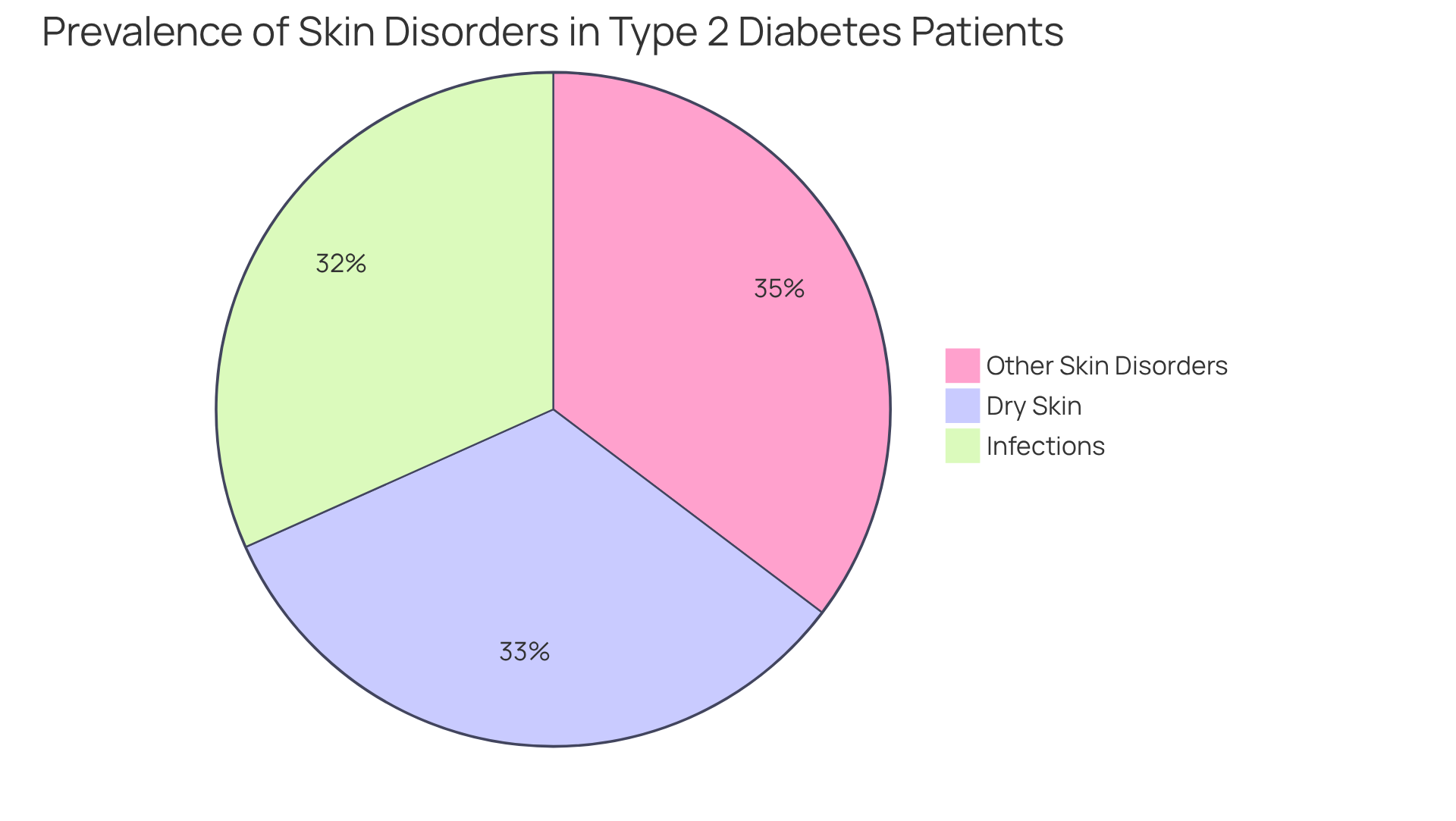
Tingling or Numbness: A Warning Sign of Potential Diabetes Complications
Tingling or numbness in your hands or feet can often signal diabetes type 2 early symptoms, which may lead to diabetic neuropathy, a common complication from prolonged high blood sugar levels damaging your nerves. It's understandable to feel concerned about this condition, as it can lead to significant discomfort and may escalate if not addressed promptly. Recent studies show that approximately 26.52% of newly diagnosed individuals with high blood sugar exhibit signs of peripheral neuropathy. This highlights the importance of being vigilant in monitoring the diabetes type 2 early symptoms.
Neurologists emphasize the value of early detection. Timely intervention can prevent further nerve damage and complications. For instance, one study found that effective glucose management can lower the risk of neuropathy by as much as 60% in Type 1 diabetes, although the benefits are more limited for Type 2. If you're experiencing tingling or numbness, it's essential to consult a healthcare professional for a thorough evaluation and appropriate management strategies.
Remember, you're not alone in this journey. T2DSolutions offers valuable resources and assistance for newly diagnosed patients, helping you manage these challenges effectively. Be sure to visit T2DSolutions for more information on managing blood sugar and to stay informed about your health. We are here to support you every step of the way.
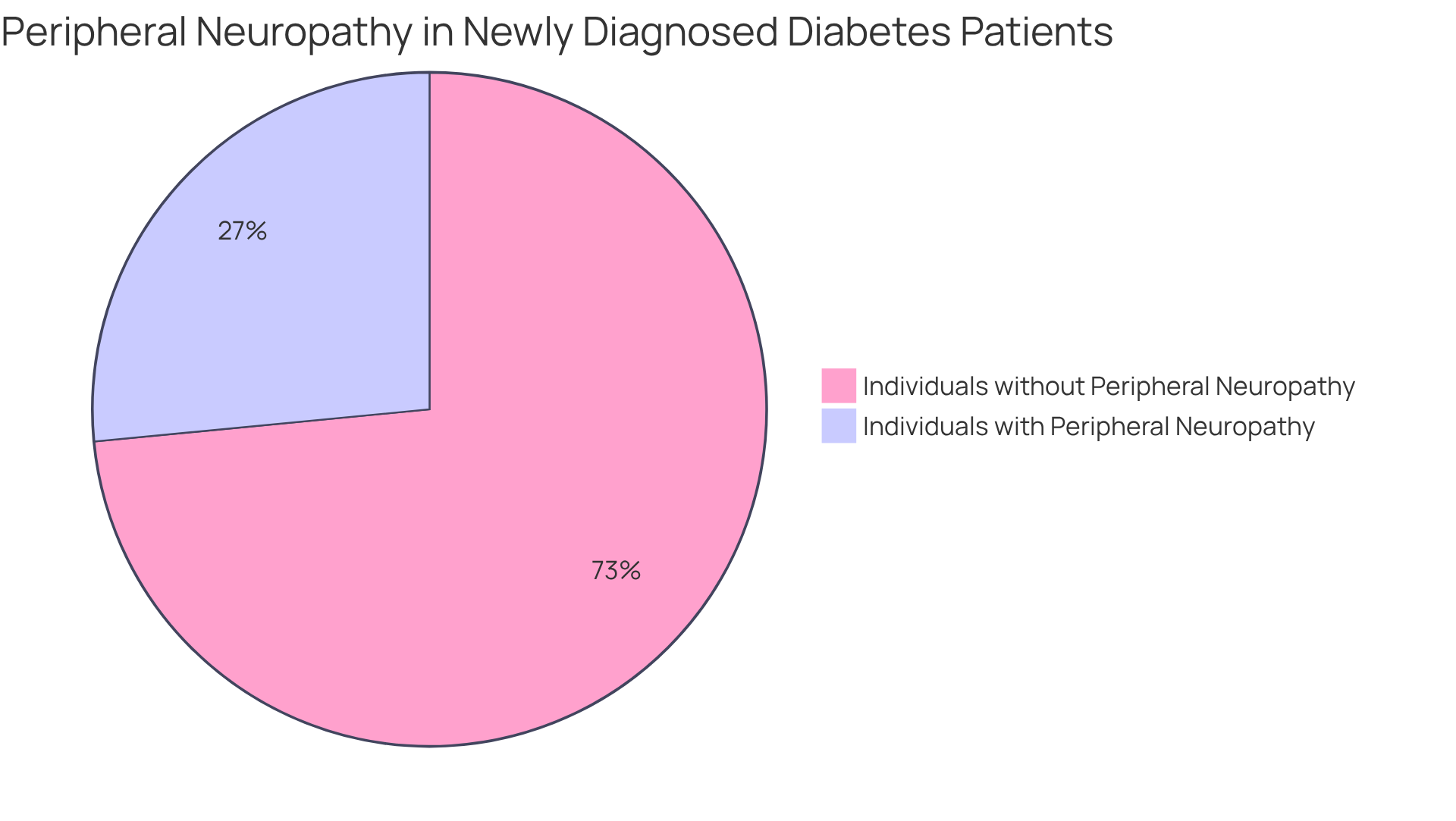
Unexplained Weight Loss: A Critical Early Symptom of Type 2 Diabetes
Unexplained weight loss can be a critical indicator among diabetes type 2 early symptoms. This often occurs when the body struggles to effectively utilize glucose for energy. When glucose isn't available, the body compensates by breaking down fat and muscle for fuel, which can lead to significant weight loss. It's important to recognize that individuals with unmanaged blood sugar levels may encounter diabetes type 2 early symptoms. This highlights the necessity for awareness and timely medical assessment.
For instance, losing 10 pounds or more without any intentional effort can be a signal of underlying health issues, such as diabetes type 2 early symptoms. While experts emphasize that intentional weight loss can improve metabolic health, unintentional weight loss should not be overlooked. According to the American Diabetes Association, about 1 in 3 adults has prediabetes, and many are unaware of their condition. If you notice unexplained weight loss, it’s crucial to consult a healthcare provider for a thorough assessment and appropriate management.
When discussing this issue with your healthcare provider, consider mentioning any recent weight changes, your diet, and any other signs you may be experiencing. Remember, you're not alone in this journey. We are here to support you every step of the way, and seeking help is a strong and positive action toward your health.
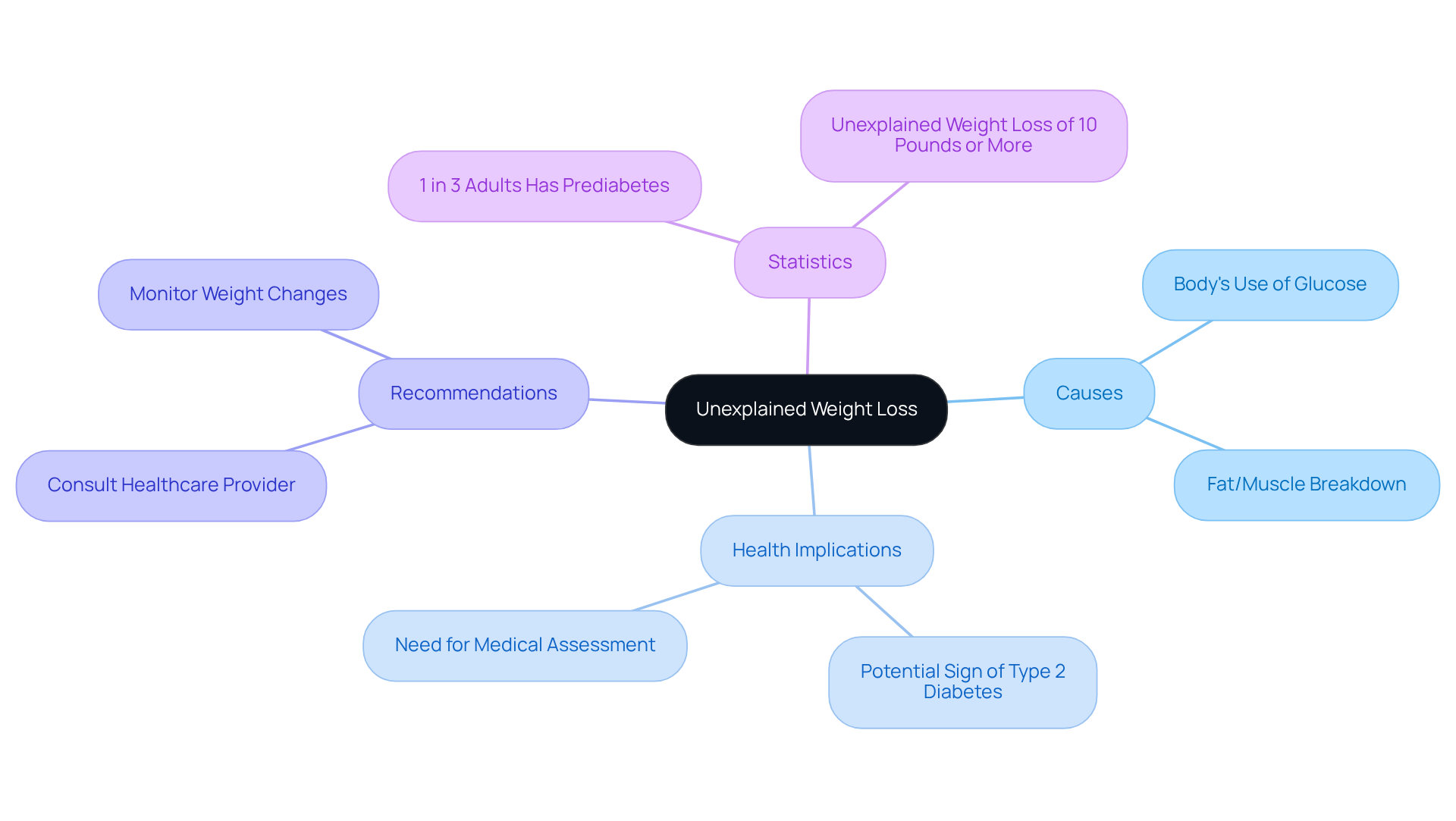
Irritability: An Often Overlooked Early Symptom of Type 2 Diabetes
Irritability can often be one of the diabetes type 2 early symptoms, commonly stemming from fluctuations in blood sugar levels. These mood changes may significantly affect your daily life and relationships, potentially leading to increased stress and anxiety. It's important to know that research shows individuals with diabetes are two to three times more likely to experience depression, which can complicate emotional well-being further.
A recent study revealed that 56% of participants with type 2 diabetes reported encountering one or more ADA indications in the past year. This highlights how common issues like irritability and fatigue can be. If you find yourself feeling more irritable, especially alongside other symptoms such as increased thirst or frequent urination, it’s crucial to consult a healthcare provider for a thorough evaluation of diabetes type 2 early symptoms.
Regular mental health screenings are also vital for effectively managing both your emotional and physical health. Addressing these mood changes early can lead to better overall health management. Remember, you're not alone in this journey; seeking help can make a significant difference.
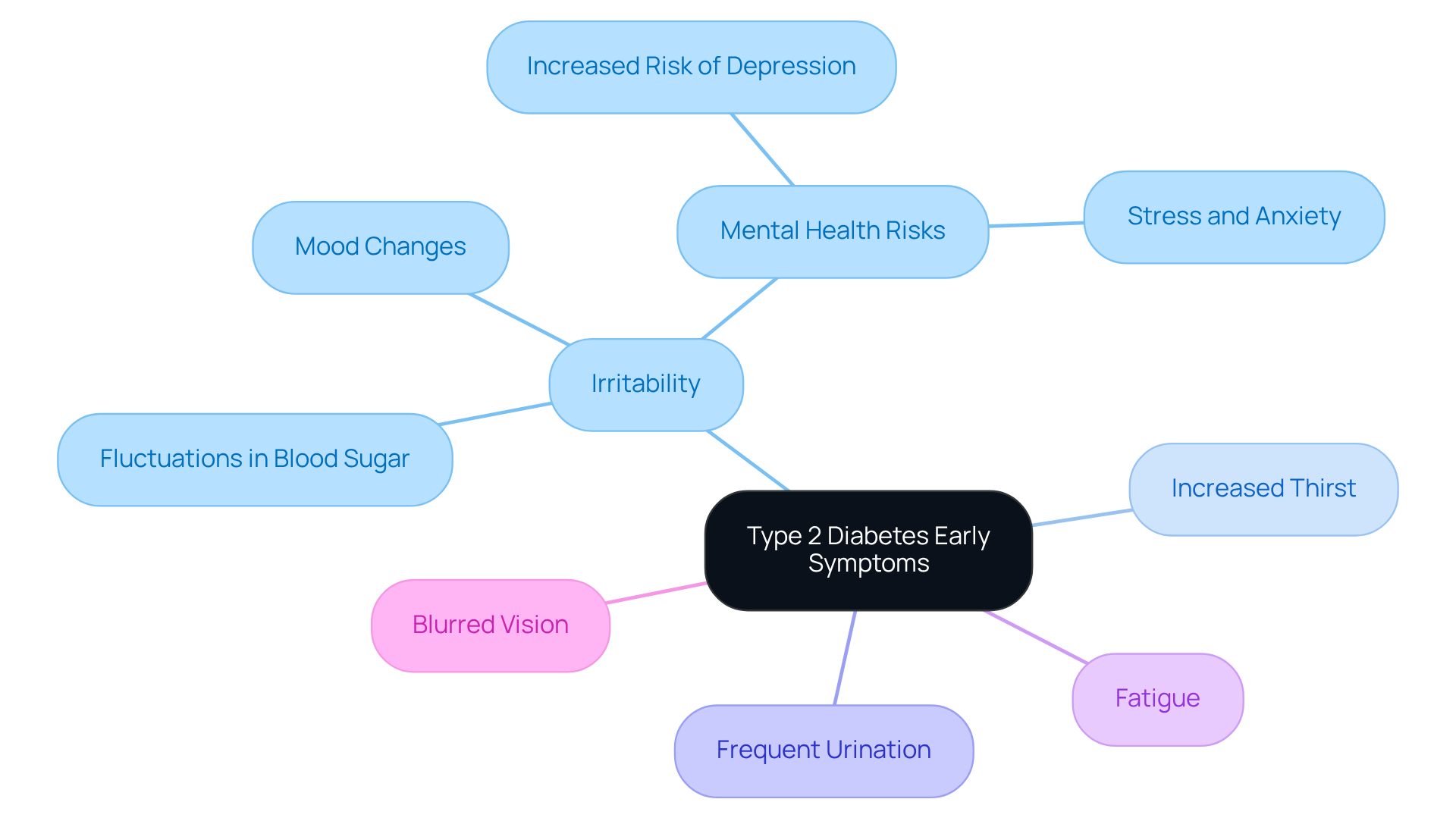
Conclusion
Recognizing the early symptoms of Type 2 diabetes is essential for effective management and the prevention of complications. Key indicators such as increased thirst, frequent urination, fatigue, and blurry vision serve as crucial warning signs. By understanding these symptoms, you can take proactive steps toward seeking medical advice and implementing lifestyle changes that can significantly improve your health outcomes.
Throughout this discussion, we also highlighted various symptoms, including:
- Increased hunger
- Skin problems
- Tingling or numbness
- Unexplained weight loss
- Irritability
Each of these symptoms underscores the importance of early detection and intervention. Timely recognition of these signs can lead to better management strategies and ultimately enhance your quality of life.
The significance of awareness and education regarding diabetes cannot be overstated. If you experience any of these symptoms, we encourage you to consult healthcare professionals for a thorough evaluation. Taking action upon recognizing these early signs is a vital step toward maintaining your health and well-being. Remember, support is available, and understanding your health is a powerful tool in navigating the challenges of diabetes. You're not alone in this journey; we are here to support you every step of the way.
Frequently Asked Questions
What are the early symptoms of Type 2 Diabetes?
Early symptoms of Type 2 Diabetes include increased thirst, frequent urination, and fatigue. Recognizing these signs is crucial for effective management and preventing complications.
Why is it important to identify early symptoms of Type 2 Diabetes?
Identifying early symptoms is vital because it can lead to timely interventions, lifestyle changes, and medical treatments that improve health outcomes and reduce the risk of serious complications.
What is polydipsia, and how is it related to Type 2 Diabetes?
Polydipsia is the medical term for increased thirst, which can occur when elevated blood sugar levels lead to dehydration. It is a common early symptom of Type 2 Diabetes.
What does polyuria mean, and why is it significant?
Polyuria refers to frequent urination, which happens when the kidneys filter excess glucose from the bloodstream, resulting in increased urine production. It is an important early symptom of Type 2 Diabetes.
How can frequent urination be mistaken for a minor issue?
Many individuals may dismiss frequent urination as a minor issue, especially if they believe it is due to increased water intake. However, if it coincides with other symptoms like excessive thirst, it is crucial to seek medical advice.
What percentage of newly diagnosed patients exhibit hyperglycemic signs like polyuria?
Studies indicate that 89% of newly diagnosed patients show one or more hyperglycemic signs, including polyuria, often within three months leading up to their diagnosis.
What should someone do if they notice symptoms like increased thirst or frequent urination?
If someone notices an increase in thirst or urination, especially if these symptoms occur together, it is essential to reach out to a healthcare provider for further evaluation and possible testing.



